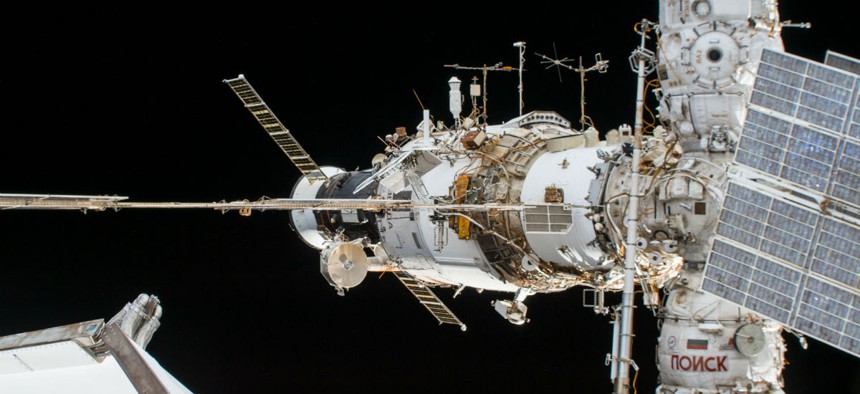
A portion of the International Space Station's Russian segment. NASA
What the Heck Happened on the International Space Station?
The puzzling story of a mysterious malfunction 250 miles above Earth.
A story emerged this week involving a surprising leak, a Russian investigation, and suggestions of sabotage, but it wasn’t set in Washington.
The story unfolded about 250 miles above Earth, where a mysterious hole was discovered leaking pressurized air out of a capsule on the International Space Station. Officials said the people on board the station—three Americans, two Russians, and one German—were never in any danger, and the leak has since been patched up. But the mystery of how it got there in the first place remains.
On August 30, in the middle of the night, flight controllers on Earth noticed that the air pressure on the ISS had dropped slightly. The change suggested there was a leak somewhere on the station. NASA didn’t wake up its own astronauts after the detection because the pressure change was too small to pose a danger to the astronauts, the agency said. Everyone was safely tucked into sleeping bags tightly secured to the wall, the best approximation of a bed in an environment where floating away without knowing it is a real problem. When they woke up, all six were instructed to scour the station for the source.
The astronauts eventually traced the leak to a two-millimeter hole in the hull of a Soyuz capsule, a type of Russian spacecraft that delivers people to and from the ISS. Since the American Space Shuttle ended in 2011, Russia offers the only transportation option to the station. The capsule had arrived in June, carrying a Russian cosmonaut, an American astronaut, and an astronaut from the European Space Agency.
Flight controllers in Russia boosted the oxygen supply to the Soyuz as a protective measure. Astronauts covered the opening with some Kapton tape, an adhesive film that remains sticky in extreme temperatures, as a temporary fix. Later in the day, the Russian cosmonauts plugged the hole with sealant and gauze. They photographed and filmed it for official records, and monitored the conditions every hour. The pressure inside the ISS eventually stabilized.
It’s lucky the leak was found now, and not in December, when three of the spacefarers are scheduled to pile into the Soyuz capsule and head back down to Earth.
With one investigation over in the Soyuz, another began. Roscosmos, the Russian space agency, has convened a committee to determine the cause of the hole. According to an update posted on the Roscosmos website on Friday, an international group of space officials will meet on September 10. They include Tom Stafford, a former nasa astronaut who has served as the chairman of the nasa Advisory Council Task Force on ISS Operational Readiness.
The Russians at first considered whether the hole was created by a type of space rock known as a micrometeoroid. Micrometeoroids are tiny, some smaller than a grain of sand, but in space they travel at thousands of miles per hour and can easily slice through metal. For decades, they have left their mark on various spacecraft and satellites. In 2013, one such rock left a visible hole in one of the solar panels on the ISS:
Bullet hole - a small stone from the universe went through our solar array. Glad it missed the hull. pic.twitter.com/iBHFVfp1p8
— Chris Hadfield (@Cmdr_Hadfield) April 29, 2013
But this week, they tossed out the micrometeoroid explanation. After examining the hole, officials determined the impact was likely made from the inside of the capsule, said Dmitry Rogozin, the head of Roscosmos.
“It is too early to say definitely what happened. But, it seems to be done by a faltering hand,” Rogozin said earlier this week, according to tass, Russia’s government-run news agency. “It is a technological error by a specialist. It was done by a human hand. There are traces of a drill sliding along the surface. We don’t reject any theories.”
And the spookiest part? They don’t know whether the hole was made when the Soyuz was still on Earth or while it was in space.
Rogozin vowed that officials will “find the one responsible for that, to find out whether it was an accidental defect or a deliberate spoilage and where it was done—either on Earth or in space.”
Here’s a photo of the hole, which nasa tweeted this week but later deleted, according to Chris Bergin, an editor at NASASpaceflight.com.
ISS Leak summary:
— Chris B - NSF (@NASASpaceflight) September 3, 2018
First thought was MMOD strike.
Then NASA released pics. Lots of people: "Hmmm, doesn't look like MMOD". NASA deleted the photos.
Top Russian news site RIA NOVOSTI reported - via sources but apparently confirmed by Mr. Rogozin - it was a drill hole. pic.twitter.com/520kHK0TMc
The quick response to the mysterious malfunction and the seemingly collaborative effort to investigate it serves as a reminder of the good relations between the United States and Russia where the International Space Station is concerned. That kind of thing is pretty rare down on Earth. Neither nation would be able to carry out this task—operating and maintaining the biggest artificial structure in low-Earth orbit—alone. They need each other’s technology, and they need each other’s money.
Operations on the ISS are split in half, with one side run by the Americans and the other by the Russians. (This doesn’t prevent them from hanging out, of course; they spend plenty of time together, and are trained to speak both English and Russian.) The Soyuz was docked to the ISS on the Russian side, and it was empty at the time the pressurized air started to escape. But a malfunction anywhere on the station, if it were serious, would endanger everyone on it.







